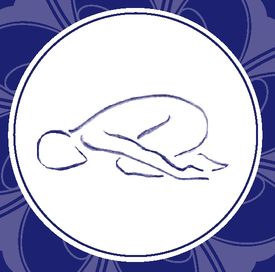balasana
CHILD’S POSE
Balasana is the pose of the child (bala), in which the body is draped over folded legs, representing a child in the womb.It is a resting pose that is often performed after a challenging asana or when we need some time to let our mind and body absorb the practice. When we are in an innocent and receptive state of mind, it is easiest to be transformed by our yoga practice.
The Childhood Play of Krishna
Although Krishna is known mostly for his role in the Bhagavad Gita, stories about his childhood involve enjoyable insights. After his miraculous birth at which all the signs of his divinity were present, Krishna grew up in the idyllic surroundings of the forests of Vrindavan. Once, when Krishna and his brother Balaram were playing in the courtyard, Krishna took a scoop of earth in his hand and ate it. When Balaram saw this, he ran to their mother, Yashoda, and told her, “Mother, Krishna is eating dirt. He may choke on it!” Unsurprised at yet another of her son’s naughty tricks, Yashoda grabbed hold of Krishna and questioned him.
“Have you eaten mud?” she demanded. Although Krishna’s face was covered with mud, he replied, “Oh no, Mother. Balaram is lying. I haven’t touched any mud.” Of course Yashoda didn’t believe him, and she made Krishna open his mouth. When Yashoda looked inside, she didn’t see any mud. Instead she saw the whole universe and all the galaxies.
Although Krishna’s parents and friends were vaguely aware of his divinity, his childish charm as a toddler made them forget. This play of forgetfulness of divinity is called lila. It facilitates the highest type of connection a soul can have in relation to the Divine. This forgetfulness allows Krishna’s friends to play and joke with him in a way that would not be possible if they were aware of (and potentially intimidated by) his divinity. In a similar way, a president of a country also needs to forget his official function when he is playing horse with his grandson riding on his back. This is one of the paradoxes in yoga philosophy: First we need to remember our divine nature, and when we are established in it we need to forget it again in order to stay engaged in the world. This is however a playful type of forgetfulness in which we do not loose connection with our soul. When Yashoda looked into Krishna’s mouth, she saw the whole of creation contained within it. Everything is in God, and God is in everything. There is no duality here, just play for the sake of play.

Transcending the Ego through Surrender
Often children are the best teachers. It is said that Yoga is actually very easy and very difficult at the same time. It is simple because the only thing we need to do is stop clinging to our ego. But that is also one of the hardest things we can do, given the subtle workings of the ego, which we continually reinforce.
According to both the Yoga Sutra and the Bhagavad Gita, the ultimate goal of yoga lies in our surrender to a higher power. Yoga is usually regarded as a practice that liberates us from the ego, but at the same time it binds us to the Divine through love. And this is what the child’s pose symbolizes. It is the childlike surrender to the Divine that opens up the pathways of grace. And all past, present, and future sages of yoga will testify that grace is what we need, as we are all dependent on something that is greater than ourselves. We often do not realize this enough, and take many things for granted—the ground we stand on, the air we breathe. But it may all be taken away from us at any moment in time. And then surrender is all that is left to us. In surrender we truly open ourselves up to receive, and also to give. Balasana invites us to cultivate this childlike quality.


